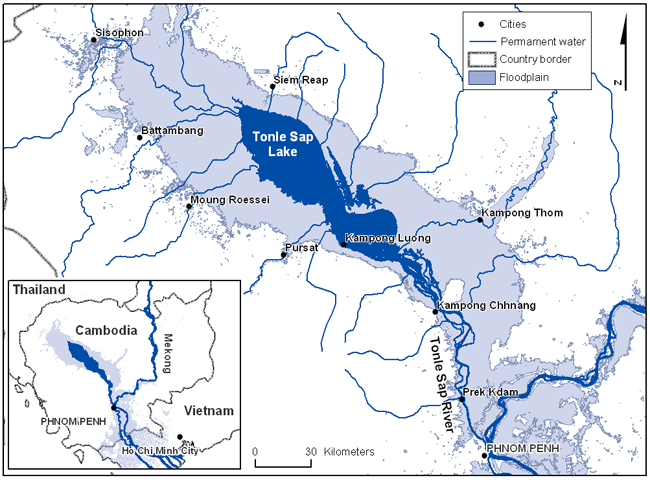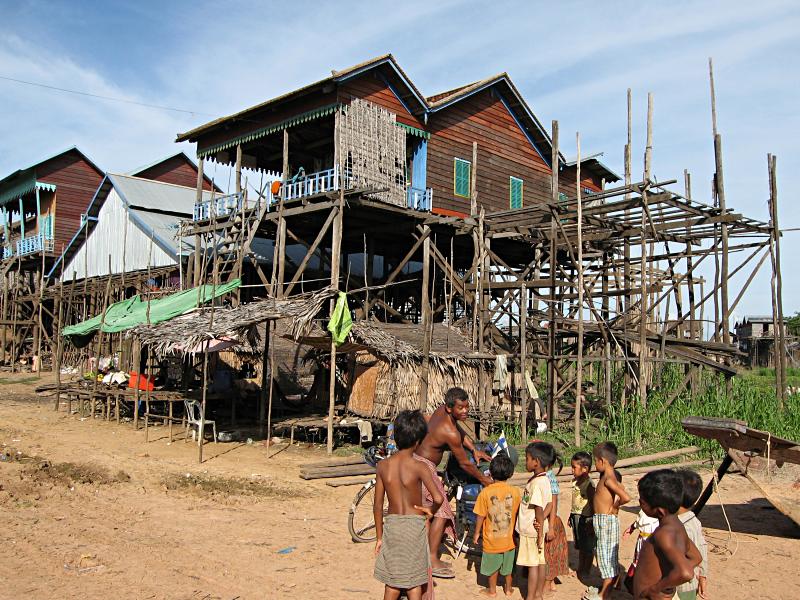Floating markets can be found in many Asian countries, such as Thailand, Vietnam, Cambodia and India. Their presence can be explained by the existence of large rivers and lakes that support the livelihoods of the people who resides along those water bodies. In the case of Cambodia, three million people live around the dumbbell-shaped Tonle Sap Lake, which is the largest freshwater lake in South East Asia.
Tonle Sap Lake is actually a floodplain that expands and contracts twice a year. During the monsoon season, the lake swells up to three times its size, which can be as big as 12,000km2. This is almost the size of the state of Connecticut! The swelling is caused by heavy rainfall and water overflowing from the mighty Mekong River to Tonle Sap via a connection between the two water bodies. However, during the dry season, the lake shrinks and the water level drops several meters to as low as 1m in depth. This hydrological cycle has brought an abundance of sediments to the lake and evolved into a rich ecosystem. In fact, Tonle Sap has been inscribed as a UNESCO biosphere in 1997.
The villagers have cleverly adapted to the ever-changing water levels as a way of life. Some live in floating houseboats and some have permanent homes that are built on 10m high stilts to accommodate the rising water level. And depending on the seasons, others live in thatched huts that can be dismantled and moved. At the lake, people socialize, fish, and trade. The amount of fish caught is so large that it accounts for more than 50% of the country’s supply. Hence the fishermen not only sell fish to the local villagers, but also bring the surplus to markets throughout Cambodia. Other types of produce are transported from the mainland by boats and sold at¬¬ the floating markets or open area along the lake.
While the river and lake are essential to the villagers’ livelihoods, the floating markets have become a key tourist attraction. Chong Khneas is the most accessible village from Siem Reap town, making it the most frequently toured floating village. Tourists can travel on either slender, manually rowed wooden boats or bigger, motor-driven tour boats. Although a typical tour is about one to two hrs, a foreigner can easily feel the pulse of the place. Despite the years of struggle and poverty that Cambodia has gone through, the floating markets epitomize the ever-hopeful youths of the nation. For instance, a young child will paddle around in his tiny tin boat to sell souvenirs or refreshments to the tourists onboard can be observed every once in a while. Along the edges of the lake, even more children can be seen waving enthusiastically to foreigners, welcoming them. For the visiting urban dwellers gliding through the waters of Tonle Sap, it is always a wonder to see how uniquely people can adapt to their surroundings – villagers going about their everyday lives, supported by amenities like floating schools and gasoline refilling stations.
Through these boat trips, tourists not only witness the daily lives and business transactions of the Khmer and Vietnamese villagers, but also appreciate how humans and nature can co-exist seamlessly for decades.



References:
trifter.com/asia-pacific/floating-markets-in-southeast-asia/
en.wikipedia.org/wiki/Tonle_Sap
www.holiday-in-angkor-wat.com/tonle-sap-chong-kneas.html
indietravelpodcast.com/article/floating-fishing-village-tonl-sap-lake-2/
www.peaceofangkorweb.com/TonleSap.htm
http://www.canbypublications.com/siemreap/srtonlesap.htm
http://www.travelblog.org/Asia/Cambodia/North/Siem-Reap/blog-316430.html
Kai Seah and Stella Chen
